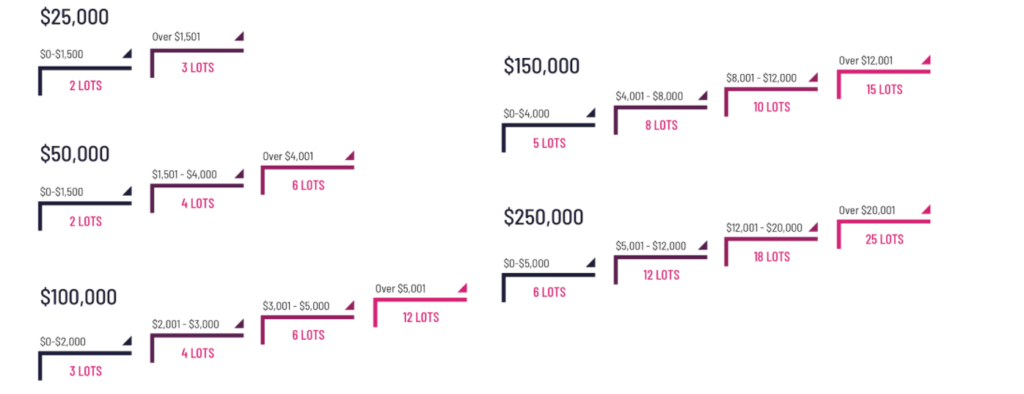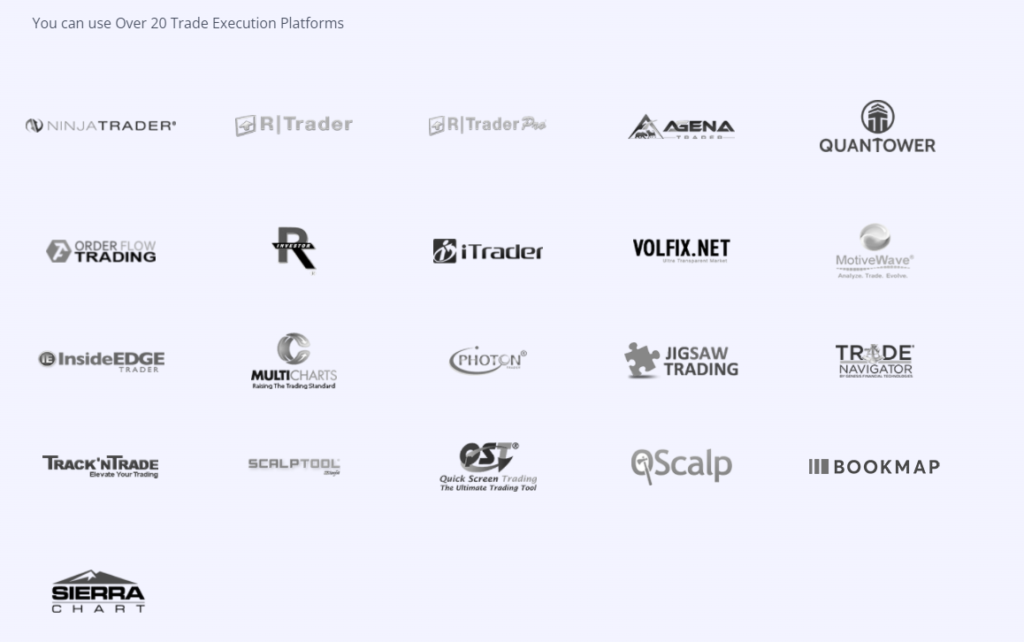In addition, any charts for financial instruments in this article are for education only. The examples shown here do not constitute trading advice or a solicitation to buy or sell any financial instrument. Past performance is not necessarily an indication of future performance.
If you would like to learn more, please read this Disclaimer for details.
OneUp Trader is one of the better futures trading funding programs out there. In my opinion, the process is brief, well-designed, and easy to understand. If you are new to the idea of funded accounts, check out this guide to answer all your general questions.
This article provides all the information you will need on your mission to earn your own funded trading account from OneUp Trader. If you’d like to read more about my personal experience, be sure to check my official OneUp Trader review next.

Note: As of August 30, 2022, OneUpTrader has increased the trader’s profit split from 80% to 90%! This helps reward the undercapitalized trader even more than before. The industry strandard is 80%, with a few other companies (such as LeeLooTrading) offering 90% as well. But with OneUpTrader’s straightforward program and funding process, I think this vaults OneUp ahead of the rest as the single best opportunity for funding as a futures trader.
The Evaluation
OneUp Trader offers 5 different account sizes for aspiring traders to pick from. The process is fairly straightforward. Upon selecting an account, the trader will subscribe to a monthly plan based on the account selected, which starts your evaluation period. You will receive an e-mail with login information, and a demo account is created for you to begin trading. This takes place within an hour or so of subscribing.

If you already have a compatible trading platform installed, you can log in with information provided in the e-mail, and begin trading right away. You can sign up at 8:00 AM CST, get your account, and start your first trading day that same morning.
The moment the evaluation account is ready, the clock starts ticking. You must trade a minimum of 15 trading days in addition to earning the required profit. This means you must place at least one trade per day for 3 full weeks. If you reach the profit target in only three days, you must continue to place at least one trade per day for the next 12 days.
A Tip for Some Extra Time
Each week provides us all with a maximum of 5 trading days. As a result, each month has about 21 trading days. You can take as long as you’d like, but keep in mind that the evaluation at OneUp Trader is a subscription. This means you can expect an extra charge each month, if you decide to take extra time. Thus, while it is possible to pass the evaluation in the first month on each account, you shouldn’t spend too much time racking up losses or screwing around if you want to avoid that second month charge. The subscription bills you on the same calendar day as the day you sign up. So if you sign up January 4th, you can expect to get billed February 4th by 2:00 PM CST.
My suggestion? Start on a Monday. If you started on January 3rd, 2022, you would have until February 3rd to complete your evaluation. This would give you just about 24 trading days. If you started on a Friday like January 7th instead, you would have until February 7th, which falls on a Monday. This would give you about 22 trading days. So while I don’t recommend procrastinating and finding your back against the wall at the end of the month, having an extra day or two might be a huge help.
Rules of the Evaluation
The rules for the evaluation are mostly self-explanatory. Depending on the account size, you must produce a certain profit in the time allotted. You can trade up to the maximum contracts as shown in the image. For example, for the $100,000 account, you can trade up to 12 contracts simultaneously. There is a trailing drawdown and a max drawdown for each account. These rules are hard rules – they will allow no exceptions.
Passing the Evaluation
After trading 15 days, if you have produced the required profits and have not violated any of the rules on the account, you are eligible to contact support and have your account reviewed. Assuming you followed everything correctly, you will receive a brief questionnaire.
This questionnaire asks general questions, but it is mostly opinionated and you don’t have to share too much. They seem to want to check that you do have a plan for how you will prepare for the trading day, what your goals are, and what kind of trader you are. I have never heard of any issues resulting from the responses on this questionnaire, so just give them a sentence or two for the open-ended questions and submit it. You will receive a contract to sign shortly after.
Once the contract is processed, which will take up to 3 business days, you will be sent a separate username and password for the funded account. You can now begin trading your own funded account!
Note that the rules vary slightly in the funded trading account. You may not trade large news events, and have to adhere to scaling targets when increasing the size of your positions. You can read about these rules in length on their website here.
The Funded Account
Good news! We can now begin to talk about the part that matters the most: how to maintain and withdraw profits from your funded account.
Funded Account Rules
Although the evaluation permits trading the max contract sizes and holding positions through news releases, this doesn’t apply to the funded account. You will have to follow a scaling system and close your positions when major news is coming out. This means that if there is an FOMC: Minutes release at 11:00 AM PST, all relevant positions need to be closed by 10:59:00 and cannot be opened until 11:01:00. Violating this rule will be the end of your account.
Scaling Targets
As for contract sizes, OneUp requires that traders limit their size based on the balance on the account. All this means is that you need to generate enough profit with smaller size before scaling into larger positions. This rule is meant to prevent traders from blowing their account on the first trade by taking a single bad trade with too much size. See the chart below for the specific scaling targets for each account.

Note that withdrawing too much profit will force you to keep your positions small. Therefore, maintaining a more comfortable buffer is necessary for those who want to scale up.
Withdrawing Profits From Your Funded Account
The priority of most traders at this point is withdrawing the money they make, to cover the expenses of the evaluation and of course, to finally start earning an income.
Withdrawing profits at OneUp Trader is fairly simple. There is a threshold on each account, above which any profits can be withdrawn, at any time. These thresholds are as follows:
$25,000 = Withdrawal Profit Threshold $1,500
$50,000 = Withdrawal Profit Threshold $2,500
$100,000 = Withdrawal Profit Threshold $3,500
$150,000 = Withdrawal Profit Threshold $5,000
$250,000 = Withdrawal Profit Threshold $5,500
There is a further requirement on withdrawals: you must request a minimum of $1000 at a time. So if you are on the $50,000 account, and earn a profit of $6000 your first week, you are eligible to withdraw up to $3500 immediately, no questions asked. The money is posted to your account within the next 1-2 days.
To request a withdrawal, you must email the support at MES Capital, which is the official funding partner of OneUp Trader. Once funded, you will be dealing with MES Capital rather than OneUp Trader for most of your issues. You can e-mail their support at any time and you should get a response relatively quickly.
OneUp Compatible Platforms

OneUp Trader is compatible with over 20 trade execution platforms. I haven’t even heard of most of these, and don’t plan on using them. But if you see your favorite platform here, I am sure you will enjoy that you can continue using the same setup.
My set up is ThinkorSwim from TDAmeritrade for my charting, and Rithmic Trader to execute my actual trades on the Order Book window. Of course, this might not feel as comfortable for others. Feel free to explore the other choices shown in the image above, and choose the one that makes the most sense for you.
Conclusion
In conclusion, OneUp Trader offers a straightforward evaluation for traders to earn a funded trading account. There are no tricks or rug pulls here. If you have questions, you can refer to the documentation available on the website, where pertinent information is explained in a simple manner. The support is relatively quick as well, so you should get the answers you need if you are still undecided.
As I explore other funding options, I will refer back to OneUp from time to time to compare certain features. Overall, OneUp is an excellent choice, and if you decide to try it out, just be sure to keep the rules and news releases in mind at the start of each trading day. You will manage as long as you follow the system as designed.

Leave a Reply